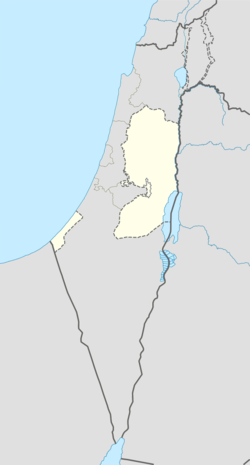
Back Gaza ACE Gasa Afrikaans Gaza AN Gaza ANG Gaza ANN غزة Arabic غزه ( قطاع غزه) ARZ Gaza AST Qəzza Azerbaijani Ғәззә Bashkir
Gaza
غَزَّة Gaza City | |
|---|---|
| Arabic transcription(s) | |
| • Latin (official) | Ghazzah |
| • Latin (DIN 31635) | Ġazzah |
Rimal in October 2023 | |
Location of Gaza within Palestine | |
| Coordinates: 31°31′N 34°27′E / 31.517°N 34.450°E | |
| Country | Palestine |
| Governorate | Gaza |
| Founded | 15th century BC |
| Government | |
| • Type | City (from 1994[2]) |
| • Head of Municipality | Yahya Al-Sarraj (installed by Hamas) |
| Area | |
• Total | 45,000 dunams (45 km2 or 17 sq mi) |
| Population (2017 Census)[4] | |
• Total | 590,481 |
| • Density | 13,000/km2 (34,000/sq mi) |
| Website | mogaza.org |
Gaza,[b] also called Gaza City, is a city in the Gaza Strip, Palestine, and the capital of the Gaza Governorate. Located on the Mediterranean coast, 76.6 kilometres (47.6 mi) southwest of Jerusalem, it is home to Palestine's only port. With a population of 590,481 people as of 2017, Gaza was the most populous city in the State of Palestine prior to the Gaza war, when it was subjected to massive displacement.
Inhabited since at least the 15th century BC,[6] Gaza has been dominated by different peoples and empires throughout its history. The Philistines made it a part of their pentapolis after the ancient Egyptians had ruled it for nearly 350 years. Under the Roman Empire, Gaza experienced relative peace and its Mediterranean port flourished. In 635 AD, it became the first city in the Palestine region to be conquered by the Rashidun army and quickly developed into a centre of Islamic law. However, by the time the Crusader states were established in 1099, Gaza was in ruins. In later centuries, Gaza experienced several hardships—from Mongol raids to severe flooding and locust swarms, reducing it to a village by the 16th century, when it was incorporated into the Ottoman Empire. During the first half of Ottoman rule, the Ridwan dynasty controlled Gaza and the city went through an age of great commerce and peace. The municipality of Gaza was established in 1893.
Gaza fell to British forces during World War I, becoming a part of Mandatory Palestine. As a result of the 1948 Arab–Israeli War, Egypt administered the newly formed Gaza Strip territory and several improvements were undertaken in the city. Gaza was occupied by Israel in the Six-Day War in 1967, and in 1993, the city was transferred to the newly created Palestinian National Authority. In the months following the 2006 election, an armed conflict broke out between the Palestinian political factions of Fatah and Hamas, resulting in the latter taking power in Gaza. The Gaza Strip was then subject to an Israeli-led, Egyptian-supported blockade.[7] Israel eased the blockade allowing consumer goods in June 2010, and Egypt reopened the Rafah Border Crossing in 2011 to pedestrians.[7][8] The city was largely destroyed by Israeli airstrikes since the start of the Gaza war in October 2023.
The primary economic activities of Gaza are small-scale industries and agriculture. However, the blockade and recurring conflicts have put the economy under severe pressure.[9] The majority of Gaza's Palestinian inhabitants are Muslim, although there is also a Christian minority. Gaza has a very young population, with roughly 75% under the age of 25. As of March 2025, almost all residents have fled or been evacuated to the Southern Gaza Strip, or killed as a result of Israel's actions in the north. Therefore, previous recorded or estimated population numbers have become outdated.[10]
- ^ Malsin, Jared; Shah, Saeed. "The Ruined Landscape of Gaza After Nearly Three Months of Bombing". WSJ. Retrieved 31 January 2024.
- ^ Cite error: The named reference
PASSIAwas invoked but never defined (see the help page). - ^ Cite error: The named reference
GazaMunicipalitywas invoked but never defined (see the help page). - ^ "Main Indicators by Type of Locality - Population, Housing and Establishments Census 2017" (PDF). Palestinian Central Bureau of Statistics (PCBS). Archived from the original (PDF) on 2021-01-28. Retrieved 2021-01-19.
- ^ The New Oxford Dictionary of English (1998), ISBN 0-19-861263-X, p. 761 "Gaza Strip /'gɑːzə/ a strip of territory in Palestine, on the SE Mediterranean coast including the town of Gaza...".
- ^ "Gaza (Gaza Strip)". International Dictionary of Historic Places. Vol. 4. Fitzroy Dearborn Publishers. 1996. pp. 87–290.
- ^ a b Gaza Benefiting From Israel Easing Economic Blockade
- ^ Gaza Border Opening Brings Little Relief
- ^ Cite error: The named reference
Oxfamwas invoked but never defined (see the help page). - ^ "Gaza has become a moonscape in war. When the battles stop, many fear it will remain uninhabitable". AP. 23 November 2023. Retrieved 27 November 2023.
Cite error: There are <ref group=lower-alpha> tags or {{efn}} templates on this page, but the references will not show without a {{reflist|group=lower-alpha}} template or {{notelist}} template (see the help page).









